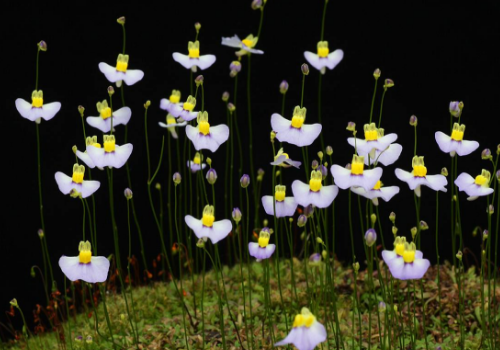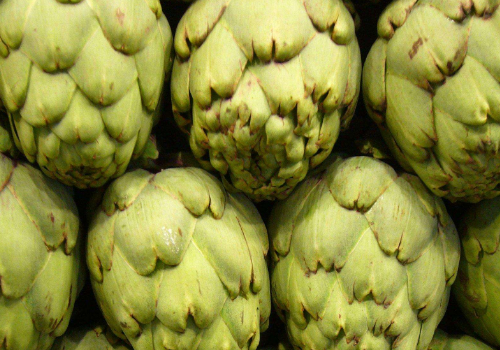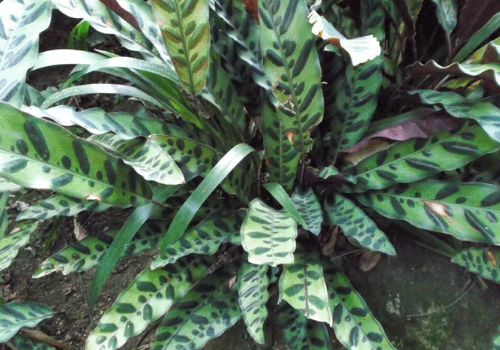How does raccoon algae eat insects in the water? how can it blossom?
Raccoon algae also need to prey on insects like pitcher plants, so how do raccoons eat insects in the water? How to blossom:
How does raccoon algae eat worms in the water:
Raccoon algae is a plant that lives in water, and it eats worms in the water no less than pitcher plants. The life span of raccoon algae is not long, it is an annual aquatic plant, but it is widely distributed all over the world. Its root system is extremely underdeveloped and degraded without a trace. Its stem is very thin, and some green hair-like filaments on it are leaves. The stem is long, like a rope, dotted with many small pockets in the dense green silk, and the small bags growing in the leaves bulge like small bubbles that seem to float. In fact, this is the tool for catching insects. These small bags are uniquely constructed, and each pocket has an opening that communicates with the outside world, with a small inward lid and four long tentacles on the lid, as if calling the bugs to play leisurely in the water. If the bug in the water swims to the opening of the bag, as long as it gently touches the hair, the lid opens inward. Many bugs thought they had found a comfortable and quiet nest, so they flowed in with the current. As a result, this "nest" is only allowed in and out. As soon as it closes the lid, the lid can only be opened inward, but it cannot be pushed out.

How can raccoon algae bloom:
Raccoon algae are mainly cultured by waist water method, water level can be high or low, like scattered light, keep above 0 degrees in winter, humidity can be 30-90%, warm green algae in the south is easy to grow, pure water or ro machine water can be used to keep the environment barren and weak acidic, use appropriate containers to let beaver algae occupy most of the area, dominate in light and space, slow down the spread of green algae, and are less heat-resistant (tricolor). Long leaves, etc.) should be put in a shady and ventilated place to avoid the heat in summer.
Now you know how to grow raccoon algae to blossom.
Southern Beaver algae Chart Guide: how to raise Southern Beaver algae / how to reproduce Southern Beaver algae Chinese name: southern Beaver algae Latin name: Utricularia australis Origin: Australian cultivation substrate: peat, water moss, perlite, sand and other living temperature: 5-35 ℃ suitable temperature: 20-30 ℃ humidity: > 60% introduction: southern beaver algae (Utricularia australis) perennial submerged or floating herbs, rootless, autumn plant apex, will produce winter buds for dormancy, spherical. The leaves are filamentous, and the insect-catching cysts are born on the leaves. Racemes axillary, Corolla yellow, lower lip red stripes, stamens 2. Capsule globose, 3-4 mm in diam., seeds oblate hexagonal. Southern beaver algae (scientific name: Utricularia australis) is a medium-sized perennial floating aquatic carnivorous plant of the genus Cerambycidae. The southern beaver algae has a vast geographical area and is found in Europe, tropical and temperate Asia, including China and Japan in East Asia, Central and South Africa, Australia and New Zealand's North Island. The species name "australis" means "south" in Latin and also reflects the fact that this species was discovered in Australia in 1810. From April to October, the Corolla is yellow, the fruit is globose, and the plant will turn red in the strong summer light. However, the leaves grow on the same side, have winter buds in winter, and the inflorescence axis has scales, which can be different from Pracaena canadensis. Peter Taylor has only observed on Chinese mainland that the species bears fruit, while in other parts of the world it blossoms rather than bears fruit. At present, there are two cases of flowering and non-flowering in the native plants in Taiwan, and some ethnic groups will bear fruit, which may be related to whether the chromosomes of this population are non-integral multiples. Latin name: Utricularia australis: phylum of plants: angiosperms: dicotyledons: Labiatae: Graconidae: subgenera: Pagrocera: subgenera: southern beaver 1, morphological characteristics of southern beaver algae perennial submerged or floating herbs, rootless, autumn plant apex, will produce winter buds for dormancy, spherical. The leaves are filamentous, and the insect-catching cysts are born on the leaves. Racemes axillary, Corolla yellow, lower lip red stripes, stamens 2. Capsule globose, 3-4 mm in diam., seeds oblate hexagonal. Plant Morphology Chinese Plant Image Database (Institute of Botany, Chinese Academy of Sciences) provides and participates in 2, growing environment ponds, lakes, paddy fields 3, distributed in Jiangsu, Anhui, Zhejiang, Fujian, Taiwan, Hubei, Hunan, Guangdong, Hainan, Guangxi, Guizhou, Sichuan and Yunnan. Southern raccoons are distributed in Europe, Africa, India, Sri Lanka, Indo-China Peninsula, Malaysia, Indonesia, Philippines, Japan and Australia. 4. During the insectivorous process, the southern beaver algae is an annual submerged herb, rootless drifting with the water, the stem is thin and soft, and the beautiful butterfly flower stands out of the water. What is particularly interesting is that there are many insect-trapping cysts at the base of its leaves, and an one-meter-long nutria has more than 1200 cysts. They prey through these insect cysts, with a valve that can open inward, with two thick green branching bristles on the edge, and tubes secreting sweet liquid next to the bristles. After small bugs or microorganisms such as water fleas, mosquitoes and flies come into contact with the stinging hairs swinging with the water, they transmit the signal to the valve and the trap sac. The original semi-shriveled trap sac expands rapidly, resulting in a pressure difference. When the valve opens, the bug flows into the sac with the water, stimulating the inner wall of the sac, and the valve will close and cannot be pushed open. [/ td] [/ tr] [/ table] Picture Guide: how to raise Pagrocera erectus / how to reproduce Beaver verticillata Chinese name: Latin name: Utricularia recta Origin: Bhutan, China, India and Nepal: peat, water moss, perlite, Sand and other survival temperature: 5-35 ℃ suitable temperature: 15-25 ℃ humidity: > 50% introduction: Pracaena erecta (scientific name: Utricularia recta) is a small annual insectivorous plant. Erect beaver algae submerged in water, up to 60 cm long, leaves bipinnately lobed, rootless, from the main axis out of short shoots, rising to the surface, seedling branches or leaflets, flower axis protruding from the water. Utricularia recta is an annual small insectivorous plant of the genus Pleurotus. The addition word "recta" comes from the Latin word "recte", meaning "erect", referring to its erect flower stem. Pagrocera erectus is distributed in Bhutan, China, India and Nepal. It is born in marshes and ranges from 900m to 4000 m above sea level. In 1859, Daniel Oliver described it as a variety of U. wallichiana. In 1968, Krishnaier Subramanyam and Banneker changed it into a variety of U. scandens. In 1986, Peter Taylor promoted it to a species after further observation of its morphological characteristics. English name: Utricularia recta: phylum of plants: Angiosperms: Labiatae: Graconidae: Utricularia subgenus: Bivalvaria species: U. recta1, morphological characteristics, up to 60 cm long, leaves bipinnately lobed, rootless, short branches from the main axis, rising to the surface, flowers or leaflets, flower rachis protruding from the water. There are cysts on the normal submerged leaves, the mouth of the cyst has an introverted valve, and there is a sensitive mechanism on the door. as soon as the bug touches the mechanism, the door opens inwardly. at the same time, the cyst suddenly expands, inhales the bug, and the door closes immediately, and the bug rots in the cyst and becomes the bait of nutria, often cultivated in aquariums. Saxifraga wetlands, leaf base out, strip spoon-shaped or strip-shaped, atrophied at flowering, yellow, flower stem [span] erect, slender, 10-20 cm tall. It is widely distributed in southern China. Dryopteris erectus, a family of dicotyledons, Chrysanthemum. Insectivorous herb in water or in wetlands, often rootless. Flowers in racemes, spikes, or solitary flowers Bisexual, zygomorphic, calyx (2) 4-lobed, odd-numbered at the rear, often 2-lipped, persistent, Corolla 5-lobed, 2-lobed, lower lobe more or less spaced, stamens only 2 in front, inserted in Corolla, anthers 1-loculed, pollen grains oblate or long globose, with one to many grooves or pseudo-grooves, exine layer as thick as inner layer, or thicker, with obscure or distinct net. The pistil is composed of 2 carpels, superior ovary, 1-loculed, special central placenta, often without style, stigma 2-lobed (posterior lobes are more or less undeveloped), with many or only 2 anatropous ovules, more or less submerged in the placenta. Capsule divided into 2-4 segments, or annular, or indehiscent, seeds one to many, without endosperm. The chromosome cardinal number is xchromosome 6, 8, 9, 11, 21. 2. Growth habits: aquatic or terrestrial, annual herbs; leaves whorled, pinnately compound, divided into numerous, filamentous lobes, lobes with vesicles at the base, or alternate in terrestrial species, often disappearing before anthesis. Flowers bisexual, zygomorphic, few, yellow, lavender or white, racemose arranged on flower stem; calyx 2-lobed, often enlarged; Corolla 2-lipped, base spurred; stamens 2; ovary superior, 1-loculed, with many ovules; fruit a small capsule. The morphology of this genus is very interesting, and the distinction between roots, stems and leaves is not applicable to this genus. In aquatic species, the leaves are silky and rootless, even in embryos. Peanuts on the short branches, protruding from the water, in addition, there are short branches on the main axis to the water, and there are very small leaves. There are many small cysts on the ordinary leaves of submerged water, that is, the insect-catching cyst, which has a membrane flap at the mouth of the cyst, and its structure is allowed to enter and not exit. If an aquatic bug swims into it, an enzyme is secreted by the hair born in the capsule to digest it as nutrition. To other terrestrial species, there are special creeping branches extending in moss or other soil layers, as well as vesicles. There are other species, such as U. montana Poir. (non-domestic species), it is an epiphyte, and its tuberous branches have water storage tissue. According to Goebel's study, these organs, that is, they are of the same origin, and the same primitive body at the growth point can be developed into any one of them, or they can change from one to the other. Similarly, after a group of spirally arranged primary leaves were produced during germination, one or two aquatic branches appeared on the side of the growth point. Although this branch was not directly related to the leaves, it was obviously homologous with the leaves. 3. Binomial Utricularia rectaP.Taylor4, synonym Utricularia scandens var. Firmula (Oliv.) Subr. & BanerjeeUtricularia wallichiana var. FirmulaOliv.[ / td] [/ tr] [/ table]
- Prev

How to grow artichoke? can I use a flowerpot?
Artichokes, this is a vegetable, is known to many people, is more attractive eyes, but the price is a setback, so how to grow artichokes? Can I use a flowerpot: how to plant artichoke: 1. Sowing time: from September to October in autumn
- Next

Matters needing attention in how to raise Arrow feather Bamboo Taro
Arrow feather bamboo taro has high ornamental value and certain medicinal value. How to raise arrows, feathers and taros? Note: how to raise Arrow feather Taro: 1. Temperature. Arrow feather bamboo taro, originally produced in Brazil and other places, is a tropical plant, preferring high temperature and humid environment
Related
- Fuxing push coffee new agricultural production and marketing class: lack of small-scale processing plants
- Jujube rice field leisure farm deep ploughing Yilan for five years to create a space for organic food and play
- Nongyu Farm-A trial of organic papaya for brave women with advanced technology
- Four points for attention in the prevention and control of diseases and insect pests of edible fungi
- How to add nutrient solution to Edible Fungi
- Is there any good way to control edible fungus mites?
- Open Inoculation Technology of Edible Fungi
- Is there any clever way to use fertilizer for edible fungus in winter?
- What agents are used to kill the pathogens of edible fungi in the mushroom shed?
- Rapid drying of Edible Fungi

